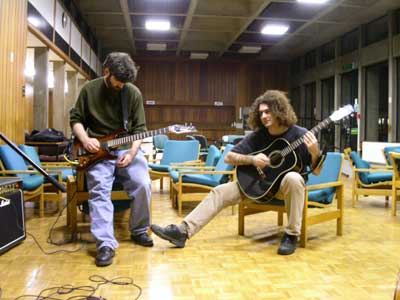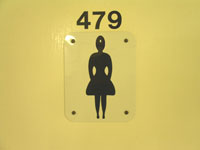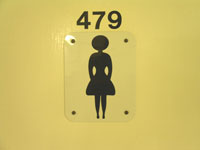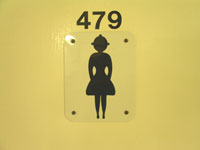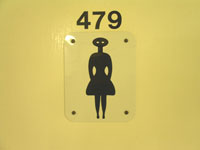February 24, 2004
the group
Flocks of geese, shoals of fish, pods of dolphins, troops of monkeys, saucers of aliens, groups of astrophysicists . . . I have been pondering the meaning of "the group" which I hear referred to often. It would seem that there is no simple answer, there are groups and subgroups, there are intersecting groups and independant groups, groups of two and massive groups, groups with no geographical confines and groups specifically located to a GPS dot. Always groups though . . . I begun to try and map them out and it soon becomes a problem of inter related areas of inquiry, part of a larger map of the overview of cosmology and astronomy, spilling into theoretical physics and beyond . . . .

Then above this diagram, above the Oxford Astrophysics group, floats the Professor, Joe Silk, as if on a brane of his own.
Talking of branes, I discovered that Carsten was a brane man, which reminded me of Hyperspace, the book. Hyperspace ended up doing my head in. In the end the excitment and anticipation of reading about timewarps and multidimensional space dissolved into frustration and a feeling of being led up the garden path. Carsten reckons its a good read so I guess I'm a dummy. Maybe the problem lies in the fact that the terrain becomes so theoretical and beyond any experimental validation that it not only is hard to grasp but begins to feel flaky.
Carsten, reassuringly, is dealing with only one extra spatial dimension, ie four spatial and one of time, 5 D. That I can grasp. We live in our 3 D spatial world on a brane, the fourth dimension. I can understand that by using the trick from Jannas book and Flatland - and Hyperspace too I have to admit - whereby one visualises what a 2 D world would be like and how inhabitants of that world would perceive a 3 D object should it pass through their world.
I wish I'd found out this was Carstens speciality before. He's off to Sheffield. Astrophysicists seem to be always on the move - hence international groups, the stretching of the ven diagrams all over the globe.
February 23, 2004
splat
This 1 second movie (100 kb) is a sketch. The tiniest experiment as a precursor to a series of films taking various trips around the unvierse.
I find it quite relaxing to loop this movie while listening to tune of the day - which is to be found in the links section down the side of the main page. Quite a nice way to space out.
February 19, 2004
17 cups of tea
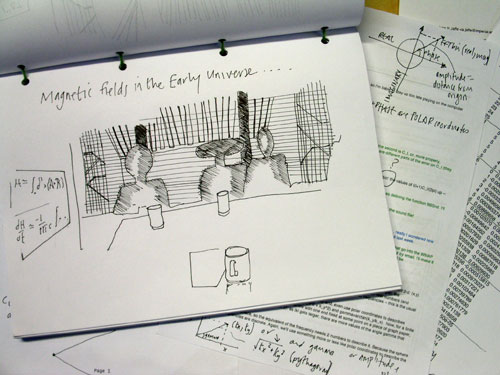
Another day banging my head against the wall of non comprehension re data, power spectrums and Fourier transforms ends with the glimmer of understanding starting to peek over the horizon.
Tea breaks seem to occur more and more often - when I first came here I was only aware of lunch and afternoon tea but now a mid morning cuppa has appeared along with more random trips to the kettle.
Inbetween a breakfast tutorial from Pedro (cup #1) and a pre afternoon tea break symposium with Andrew Jaffe, I went to a lecture about magnetic fields in the early universe. (Itself sandwiched between another two cups of tea).
February 17, 2004
shhhhh . . . I'm trying to listen to the universe
Last night the Royal society hosted a lecture entitled "Heavenly music: the sounds of the universe". The blurb started off with the familiar refrain, "[We all know that] in space nobody can hear you scream".
Back on earth, in the lecture theatre, it was pretty hard to hear anything at all given the wimpy PA.
The sounds on offer ranged from the terrestial - lightning, the aurora - through pulsations of the sun and lightning whistlers on Jupiter to the interstellar - pulsars, blackholes - and finally what was claimed to be the sound of the big bang.
The big bang sound was created from CMB data which, given my efforts documented below, was of great interest. Compared to the buzz saw tones of my first sounds (12/2/2004) this was easy listening. Einsturzende Neubauten versus Dido.
So which sound is correct ? Well obviously neither . . . it all depends how you use the data. At this point I'm trying to understand the method J Cramer used and I'm still trying to figure out how to input the data into an IFFT.
Listening to the sounds last night one thing was sadly missing and that was a loud, powerful, full frequency range sound system. To listen to the sounds of the universe, created by enormous mind boggling energies - often at extreme low frequencies - one wanted to feel the physicality of the sound, to listen to them not on a polite pair of dinky speakers but on a huge system at maximum volume, sub bass ripples of the universe churning ones belly.
February 14, 2004
Satellite of Love
rehearsal #3 : Chiara Caprini came and sat and listened for a while, then she sang this song.
February 13, 2004
February 12, 2004
The tuning of the universe, part 1
Ok, so here finally is a transposition of the CMB data into sound. It's not very pleasant and it's rough and unsophisticated. Sounds like a buzz saw.
I've taken the 2001 amplitudes and assumed a bandwidth of the entire audible spectrum. Seeing as how this spans 3 orders of magnitude, as does the measurement of angular resolution in the data, this seems fair enough. The frequencies then are worked out by slicing the range of 20 hertz to 20,000 hertz into 2001 bits.
I tried to put the data into Klank in SuperCollider but 2001 frequencies proved to much for it. In the end I had to settle for 251 to make it run so I kept every eighth amplitude and threw the rest away and sliced the frequency range by 251.
Klank is "a bank of fixed frequency resonators which can be used to simulate the resonant modes of an object. Each mode is given a ring time, which is the time for the mode to decay by 60 dB" - here then the idea is to think of the universe as an object with resonant modes as described by the CMB data and then give it a hefty clout to make it ring. The "clout" is provided by pink noise.
Listen here to :
CMB, peak frequency at 2251 hz (1 MB)
CMB, transposed,peak frequency at 9004 hz (0.9 MB)
CMB, transposed, peak frequency at 4520 hz plus CMB, transposed, with peak frequency at 9004 hz (0.75 MB)
Hopefully a more sophisticated approach will appear soon. Stay tuned . . . . and play it loud !
February 11, 2004
Susy Darkmatter
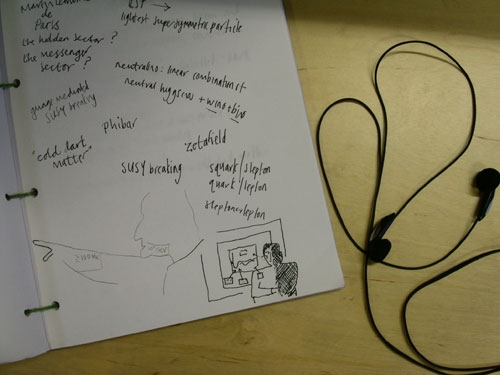
I was wondering who Susy Darkmatter was. She isn't anybody, she's a thing.
Martin from Paris came over to give a talk called "Dark Matter and Guage Mediated Supersymmetry Breaking". Dark matter is all the rage and you can't even see it.
The way I understand it is that some cosmologists weigh the universe and having done so note that there isn't enough observable matter to account for the mass they calculate. So the conclusion is that there is a whole load of matter that can neither be seen nor detected. So they look for it by various cunning means, looking for the effects it has on observable matter, looking for neutrinos down dark mines, waiting for them to splat into detectors buried far from the influence of less elusive particles.
Martin has a very beautiful power point presentation. The font is very friendly, like a relaxed felt tip pen, the i's have big dots, almost child like. Very reassuring for the uninitiated. There are lots of colours highlighting text in boxes. In fact the colours are like highlighter pens or the colours one finds on post it stickers.
Often he wanders inbetween the beam and the screen and becomes covered in equations, charts and text. On more than one occasion he is labelled "cold dark matter", "gravatino" and once, "susy".
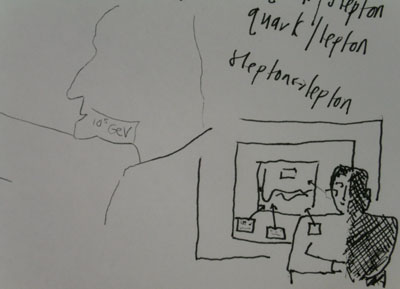
February 6, 2004
enter the robot

Most peculiar. Into my lap has landed a robot.
A couple of years ago Marcia Farquhar ran a project from Hamburg called "Artpal". I was invited to send something, whatever I wanted, to a certain individual in Hamburg. This I did and since then an exchange of packages has ensued. I've received a few things, video, a computer program . . . Last weekend my artpal was due to visit London and emailed to see whether we could meet (we never have). This wasn't possible because I had to go away, coincidentally to Hamburg, but I offered him the chance to stay in our house which he did. When I got home I found the robot sitting on the floor. So . . . now I have a robot.
One of the interesting things about it / him / her is that on its top there is a fixing for a camera. The robot is designed for exploring spaces. Artpal wrote that he originally wanted me to have it to send him film of where I lived, to "spy". Of course having stayed in my house this was no longer neccesary.
In the tradition of low tech extra planetary exploration I decided that robot could be put to good use exploring the Astrophysics department and to that end set it loose.
Its erratic behaviour suggests that some reprogramming is necessary before it can embark on an epic journey.
Here's a short film of an early stroll :
click on image to play movie
CMB data crashes computer shock
Now that I have the data in a form that I can use I'm trying to input it into an IFFT (inverse fast fourier transform), to reassemble the components into one sound, one waveform, but haven't worked out the trick to doing that yet in either Max/MSP or SuperCollider.
I tried to load the CMB data, as 2001 frequencies and their corresponding amplitudes, into Klank, a SuperCollider object, a bank of resonators. Programming wise this is far simpler . . . but it crashed the computer !
February 5, 2004
Big Eyed Beans from Venus
rehearsal #2 : grappling with the compexities of Captain Beefheart's compositional genius. The resolution of which proved to be a collision with Bo Diddley.
